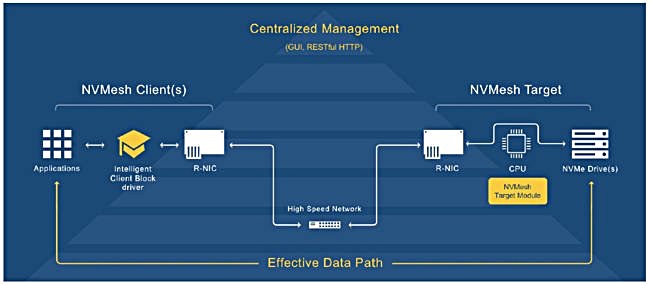Excelero has made its scale-out NVMe-oF array software available on Azure.
NVMe-oF (NVMe-over-Fabric) extends a server’s PCIe/NVMe protocol across network links. This means a server application can access remote flash drives for block data at RDMA speeds.
It will support more public clouds and we understand this to mean AWS and GCP.
Excelero’s NVMesh software is deployed as a virtual, distributed flash array. It supports both converged (in-server SSDs) and disaggregated (all-flash array) architectures.
Aman Verma, Microsoft Azure’s HPC product manager, said: “Excelero’s NVMesh on Azure’s InfiniBand-enabled H- and N-series virtual machines provides an exciting new scalable, protected storage option for several high growth segments of the market, including HPC and AI workloads.”
Excelero CEO Yaniv Romem said: “NVMesh on Azure bridges the gap between what the market offers and what enterprises require.”
He said it helped avoid “over-provisioning of storage” so users could “embrace hybrid- and multi-cloud strategies assuring performance, agility and cost control.”
Features
According to Excelero, the H-series VMs have many fast cores, with both NVMe and InfiniBand for high performance. The N-series VMs have GPUs and InfiniBand and can access storage in H-series VMs running NVMesh targets and clients.

The pitch is that you can run database and analytics workloads and high performance compute on Azure’s CPUs and GPUs without stalling for I/O. Customers can use the same methods and deploy the same software stack on-premises and in the Azure public cloud.
Users deploy Excelero on Azure using an Azure Marketplace image and Azure Resource Manager templates. The storage connectivity options include NFS, iSCSI, NVMesh-direct as well as NVMe-oF. NVMesh protects data on Azure by mirroring across NVMe drives. Customers can spread data across availability zones for extra protection.
An alternative Azure deployment method is to use a CSI plug-in with a native Red Hat OpenShift operator. This fits in with Excelero on-premises OpenShift sites as it provides a unified hybrid cloud experience.
Excelero said beta testing showed NVMesh on Azure provides up to 25x more IO/s and up to 10x more bandwidth to a single compute element from a protected Azure storage layer, while reducing latencies by 80 per cent.
Its competitors on Azure include NetApp’s Cloud Volumes ONTAP as well as Pure’s Cloud Block Store and Silk’s VisionOS block storage software. It’s getting pretty crowded in there.